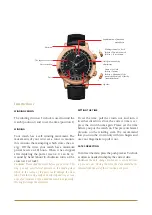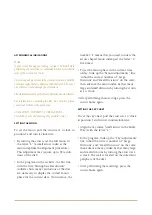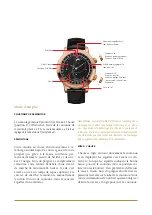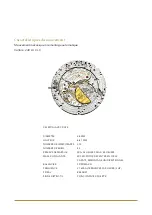
Celestial mechanics
To implement the fascinating vision of a moving
nocturnal sky, Patek Philippe developed a system
of superposed sapphire-crystal disks that rotate at
different speeds and convey an amazing impression
of depth. The background is provided by a black
sapphire-crystal disk in a wheel with 279 teeth;
it tracks the orbital position of the moon. Via a
planetary gear system, it also drives a wheel with a
small sapphire-crystal disk that displays the moon
phases in a small round aperture. A 356-tooth wheel
above it rotates a transparent sapphire-crystal disk
that depicts the sky chart on the front side and a
representation of the Milky Way on the opposite
side. The three disks, each merely two tenths of
a millimeter thick, are protected by the sapphire-
crystal glass, which on the inside features an ellipti-
cal contour that frames the portion of the heavens
that are visible from Geneva and all other places
with the same geographical latitude.
Stellar precision
With this unique mechanism, Patek Philippe has
achieved a nearly incredible degree of precision
in the astronomical depiction of the heavenly
canopy. A lunar day is defined by the time that
elapses between two consecutive passages of the
moon across a given meridian; on average, it lasts
24 hours, 50 minutes, and 28.328 seconds. A luna-
tion (the period of time between two consecutive
full moons) has an average duration of 28 days, 12
hours, 44 minutes, and 2.82 seconds. A sidereal
day is defined as the time between two consecu-
tive passages of a fixed star (such as Sirius) across
a given meridian; its average duration is 23 hours,
56 minutes, and 4.09892 seconds.
To assure correct displays, these deviations from
mean solar time require appropriate step-up and
reduction gear ratios in the going train that trans-
mits the force from the spring barrel of the move-
ment to the individual astronomical indications.
Some of these ratios rely on the accuracy of the
moon-phase display versus the sidereal day, oth-
ers on the accuracy of the sidereal day versus the
orbital position of the moon, etc. Overall, more
than 25 billion (25,000,000,000) variations were
calculated for the transmission ratio pairings of
the going train. From this staggering number of
ratios, Patek Philippe picked the optimal set that
resulted in the smallest possible deviations for
all displays. The outcome of the computations
surpassed all expectations:
• The deviation for the lunar day is 0.05
seconds per day, 18.385 seconds per year, or
30 minutes and 38.5 seconds per century.
• For a sidereal day, the deviation is 0.088
seconds per day, 32.139 seconds per year, or 53
minutes and 33.9 seconds per century.
• The moon-phase deviation is 6.51 seconds per
lunation.
Содержание Reference 6102
Страница 1: ...English Fran ais Deutsch Espa ol...
Страница 2: ...English...
Страница 9: ...Fran ais...
Страница 16: ...Deutsch...
Страница 23: ...Espa ol...





































